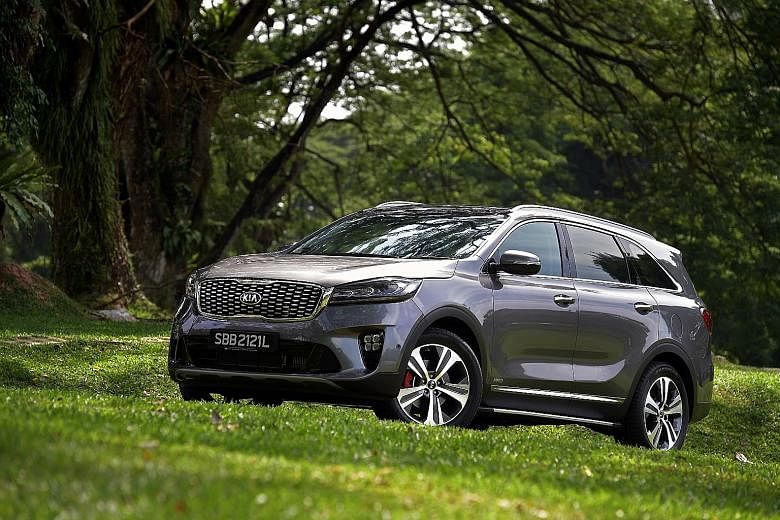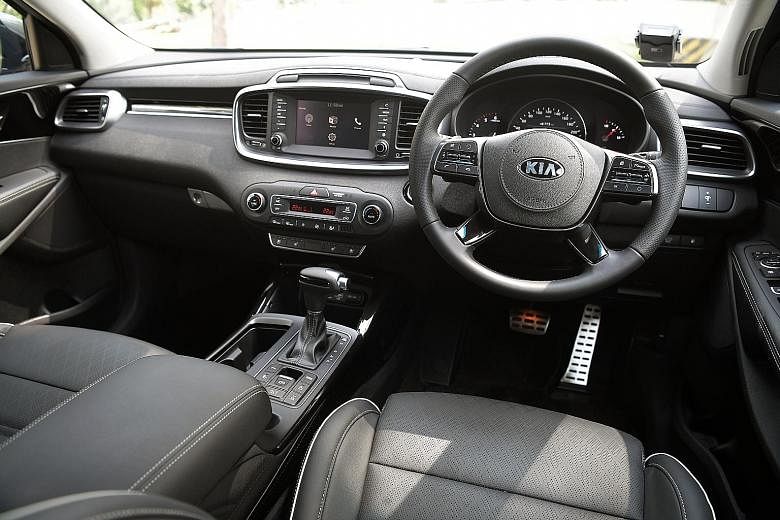The Kia Sorento GT Line is the most expensive car sold by the South Korean marque in Singapore.
At $185,999, the seven-seater sport utility vehicle (SUV) is more than twice the price of the entry-level Kia Cerato K3 sedan. The car is also costlier than Japanese equivalents such as the Mitsibishi Outlander ($148,999) and Honda CRV ($166,999).
The high price reflects Kia's confidence in the car, which is not entirely groundless.
The Sorento reviewed here is an improved version of the third-generation model launched in April 2015. Back then, the Sorento made such an impression that it was among 10 cars that were in the running for the annual Straits Times Car of the Year award.
The Sorento did not win, but it was ranked the highest for value for money.
Its engine is still the same 2.2-litre turbodiesel from 2015. The car gets new bumpers, as well as new head and tail lights. But only Kia enthusiasts can spot the differences.
The most significant update lies beneath the sheet metal - a new eight-speed automatic gearbox, up from the previous six-speeder.
-
SPECS / KIA SORENTO GT LINE
Price: $185,999 with COE
Engine: 2,199cc 16-valve inline-4 turbodiesel
Transmission: Eight-speed automatic with paddle shift
Power: 200bhp at 3,800rpm
Torque: 441Nm at 1,750-2,750rpm
0-100kmh: 9.3 seconds
Top speed: 203kmh
Fuel consumption: 6.5 litres/100km
Agent: Cycle & Carriage Kia
The gearbox offers Eco, Comfort, Sport and Smart drive modes.
The car always resets to the default Comfort mode each time it starts. This is just as well. The Sorento is not a sporty car, even though it has paddle shifters and red brake callipers.
Its steering is clinical and its suspension softly sprung.
The big SUV is, however, effortless to drive. With 441Nm of torque on tap, tasks such as quick overtaking and climbing up spiralling carpark ramps are accomplished easily.
The car comes with a number of premium features, including ventilated seats, panoramic sunroof and self-parking.
There are other thoughtful little touches. For example, when I approach the car with the key in my pocket, lights at the front door handles come on. And when I stand at the rear for about three seconds, the tailgate automatically opens.
Another appealing aspect of the Sorento is its third row. Size-wise, the Sorento sits between full-size seven-seater SUVs, such as the Volvo XC90 and Audi Q7, and compact five-plus-two seaters such as the Honda CRV.
But price-wise, it is closer to the latter.
Over a 217km test-drive, I recorded fuel consumption of between eight and 10 litres per 100km. This is higher than the official 6.5 litres figure, but still acceptable.
But other aspects of the car are less so. The gearbox has a T-shaped lever, a design that was common in cars of the 1980s. I find the grip uncomfortable and the design out of sync with the interior.
And each time the engine shuts down when the car is stationary at the traffic lights, a warning message appears on the touchscreen display with a chime. "Battery Discharge Warning! Please use the system with engine running." The warnings stop only after the engine cut-off feature is deactivated.
While the car is laden with technology, there is a glaring omission: a blind spot detection function.
During my drive, a dark grey Honda S2000 crept up to my left blind spot along Braddell Road. I checked twice before switching lanes and still missed the low-slung car. I sensed a car was there, leaned forward and straightened my back to get a higher line of sight and only then did I see the soft-top of the roadster.
These niggles aside, the Sorento is a capable car and a sensible choice. It will appeal to drivers who are not bothered by the car wearing a Korean badge.
If its weaknesses can be fixed, the Sorento will not just be good. It will be great.



